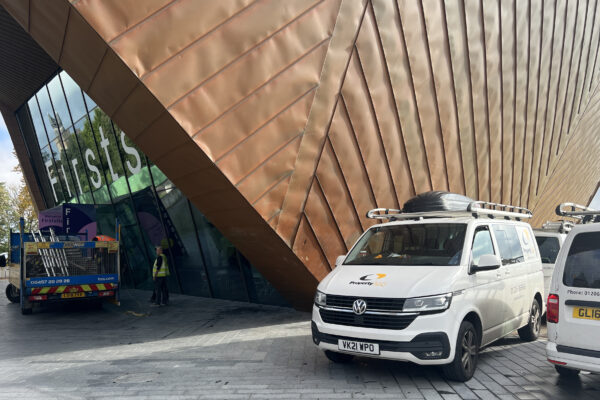
Greening up Britain?
It may look green, but don’t be fooled
The construction industry is coming under increasing pressure to improve the energy performance of its commercial and residential buildings and this has resulted in an explosion in the use of questionable synthetic materials for roofing, insulation, damp proofing, glazing and groundwork. Many would argue, however, that the potential recycling problems this will cause for the future are unavoidable if the UK is to meet its ambitious emissions targets for 2050. One synthetic material becoming increasingly common in new build homes, however, cannot be justified on any environmental terms – it is artificial grass.
The global market in artificial grass has reached a staggering £5.8bn annually and is growing rapidly. An increasing number of British gardens are being dug up and replaced with plastic grass, and even though today’s artificial grass is far more convincing than it used to be, it still suffers from the same, massive disadvantages:
• Laying an artificial lawn is not a cheap exercise. In addition to the initial cost, which can run into thousands of pounds for a decent size lawn, there is even more preparation work required than for a real lawn, with large amounts of sand and gravel required. The ground also has to be rolled, contained and absolutely level for a presentable result.
• Fake grass blocks access to the soil beneath for burrowing insects, such as solitary bees, and the ground above for soil dwellers such as worms, which will be starved of food beneath it. It provides food for absolutely no living creatures. This is a particular concern in view of the dramatic global decline in insect species. The UK is on course to miss its own targets for protecting its natural spaces, and has lost 97% of its wildflower meadows in a single generation.
• The common practice of replacing soil with sand to provide a more stable bed for the fake grass also releases even more CO2 stored in the earth
• There is also the matter of microplastics: the tiny particles of plastic that have made their way throughout the globe, and are present in our food, water and even the air. Despite industry claims that artificial grass does not shed plastics, experience of all synthetic technologies shows that such claims are never justified in the long term. Most building industry professionals will be familiar with the marketing claims of companies trying to sell their products: ‘lifetime guarantee’, ‘no maintenance’, ‘covers in one coat’, ‘harmless to wildlife’, we’ve heard it all before.
• There are also growing concerns about the impact of the synthetic chemicals that are added to artificial grass on human health and the environment. The EU has been investigating specialist artificial turf used on sports fields for suspected carcinogens, and is considering banning intentionally added microplastics. While these are different products to those sold to home gardeners, artificial pitches are sometimes reused for landscaping.

A real, live lawn provides food, shelter and habitat for a wide variety of species essential to your garden.
• And what happens to fake grass when it reaches the end of its life in 10-15 years? Apart from the obvious environmental/landfill aspect, the hapless/gullible homeowner will be required to pay out all over again for a new installation. Some manufacturers claim that their ‘grass’ can be recycled in specialist manufacturing plants, but in reality this would make the recycled product prohibitively expensive.
• While there may be an argument for artificial grass instead of concrete, the idea that artificial turf is maintenance-free is totally false. It still needs to be cleaned of litter and moss growth, and some owners have simply replaced the mower with the vacuum cleaner.
For all but specialised purposes fake grass does not compare with the real thing. Not only does it not provide any of the environmental benefits of grass – like soaking up moisture, home for insects, feeding birds, self-sustaining – its life isn’t that long. It gets trampled on and quite soon looks poor. It can’t be relaid or reseeded; it has to be rolled up, lifted and sent to landfill.
…any environmental impact resulting from mowing or watering a real lawn is dwarfed by the pollution and carbon release in the manufacturing of fake grass and the potentially colossal landfill problem down the road.
Unsurprisingly, however, artificial grass manufacturers take a different view, citing what they see as genuine environmental benefits of artificial grass:
• Fake grass doesn’t need to be mowed – with electric or fossil fuel mowers – or watered, which is a serious consideration as the UK anticipates increasing water stress due to the climate crisis.
• Nor does it require fertilisers or herbicides, some of which have been subject to huge controversy, to achieve a uniform look.
It should be said, however, that any environmental impact resulting from mowing or watering a real lawn is dwarfed by the pollution and carbon release in the manufacturing of fake grass and the potentially colossal landfill problem down the road.
Andy Driver, sales and marketing director for the artificial turf supplier Evergreens UK, says that as artificial grass has become much cheaper and more realistic, it now appeals to a wide range of people: city residents with shaded gardens where grass doesn’t grow well, or to carpet urban rooftops and balconies; families with children or dogs who don’t want a muddy mess; older or disabled people who struggle to maintain a garden; schools and nurseries where playgrounds get heavy use.
“In the mindset of the British public you haven’t really got a garden unless you’ve got a lawn,” he says. “And I think a lot of people are put off by lawns because there’s so much quite confusing technical speak around it like mowing, feeding, weeding, moss control and overseeding. A lot of people just aren’t interested – they don’t have time in their busy lives.”
But lawns can easily be maintained without any negative practices and products, and the environmental problem is real, especially given that residential gardens have become such a major wildlife habitat in the UK.
Low maintenance alternatives like planting shady front gardens with tolerant shrubs, such as evergreen bushes will provide greenery all year round, suppress weeds, offer food for wildlife and places for birds to nest, and give hedgehogs and frogs cover to travel safely in urban streets. They are also far cheaper and longer lasting than fake grass.
A recent Royal Horticultural Society ’Greening Grey Britain’ survey has found a threefold rise in the number of front gardens that have been paved over. This has now begun to have wider impacts, not just for flooding, excess run off into our rivers and increased pollution, but for our wildlife as well:
“Due to loss of natural habitat, the west European hedgehog (Erinaceus europaeus), once common across the British Isles, is now vulnerable to extinction in the UK. Cities and towns are especially important for conservationists to consider in any action plans, hedgehogs are found in almost 73% of major cities located within the hedgehog’s range in Europe – a figure illustrated by the number of the small mammals living in England’s capital.”
A recent ZSL study of London’s open spaces and domestic gardens

Hedgehogs are just one example of the many UK species facing catastrophic decline, large numbers of birds, insects, amphibians and mammals depend on our genuine green spaces for food and homes.
To Trevor Dines, botanical specialist for charity Plantlife, the popularity of artificial grass shows how disconnected we have become from the natural world. “Whenever I see artificial grass my heart sinks – more nature smothered by more plastic. Where once we were famed for our lawns, we now opt for artificial, low-maintenance solutions.
“This is not just to the detriment of wildlife but to us, too; children can’t make a daisy-chain on a plastic lawn.”




